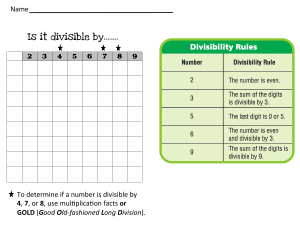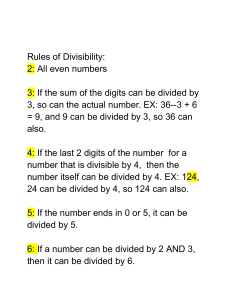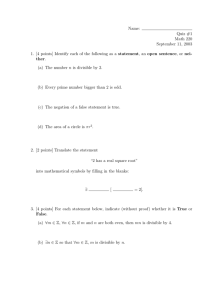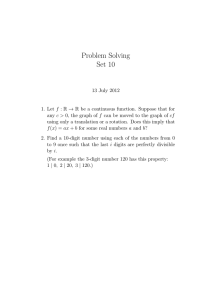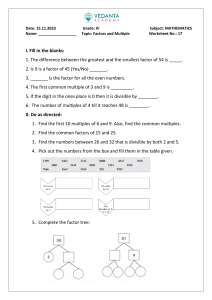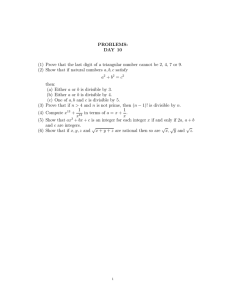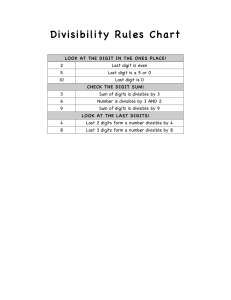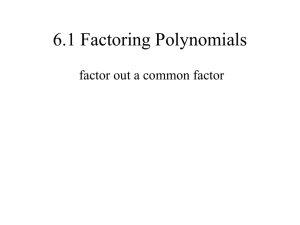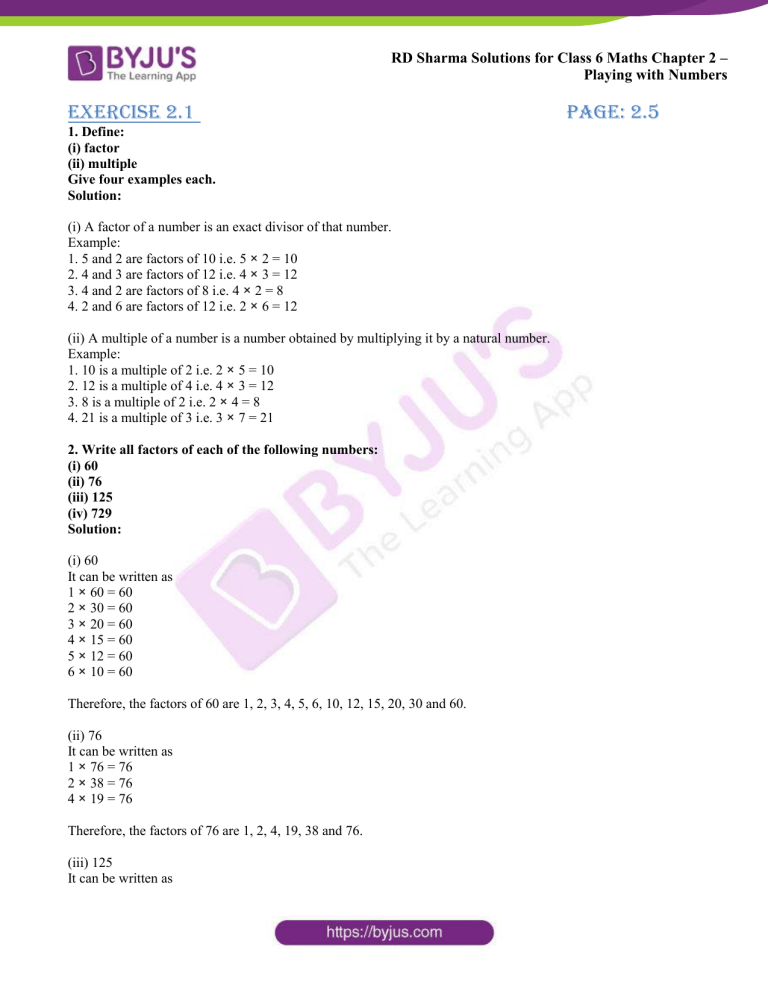
RD Sharma Solutions for Class 6 Maths Chapter 2 – Playing with Numbers Exercise 2.1 1. Define: (i) factor (ii) multiple Give four examples each. Solution: (i) A factor of a number is an exact divisor of that number. Example: 1. 5 and 2 are factors of 10 i.e. 5 × 2 = 10 2. 4 and 3 are factors of 12 i.e. 4 × 3 = 12 3. 4 and 2 are factors of 8 i.e. 4 × 2 = 8 4. 2 and 6 are factors of 12 i.e. 2 × 6 = 12 (ii) A multiple of a number is a number obtained by multiplying it by a natural number. Example: 1. 10 is a multiple of 2 i.e. 2 × 5 = 10 2. 12 is a multiple of 4 i.e. 4 × 3 = 12 3. 8 is a multiple of 2 i.e. 2 × 4 = 8 4. 21 is a multiple of 3 i.e. 3 × 7 = 21 2. Write all factors of each of the following numbers: (i) 60 (ii) 76 (iii) 125 (iv) 729 Solution: (i) 60 It can be written as 1 × 60 = 60 2 × 30 = 60 3 × 20 = 60 4 × 15 = 60 5 × 12 = 60 6 × 10 = 60 Therefore, the factors of 60 are 1, 2, 3, 4, 5, 6, 10, 12, 15, 20, 30 and 60. (ii) 76 It can be written as 1 × 76 = 76 2 × 38 = 76 4 × 19 = 76 Therefore, the factors of 76 are 1, 2, 4, 19, 38 and 76. (iii) 125 It can be written as page: 2.5 RD Sharma Solutions for Class 6 Maths Chapter 2 – Playing with Numbers 1 × 125 = 125 5 × 25 = 125 Therefore, the factors of 125 are 1, 5, 25 and 125. (iv) 729 It can be written as 1 × 729 = 729 3 × 243 = 729 9 × 81 = 729 27 × 27 = 729 Therefore, the factors of 729 are 1, 3, 9, 27, 81, 243 and 729. 3. Write first five multiples of each of the following numbers: (i) 25 (ii) 35 (iii) 45 (iv) 40 Solution: (i) 25 It can be written as 1 × 25 = 25 2 × 25 = 50 3 × 25 = 75 4 × 25 = 100 5 × 25 = 125 Therefore, the first five multiples of 25 are 25, 50, 75, 100 and 125. (ii) 35 It can be written as 1 × 35 = 35 2 × 35 = 70 3 × 35 = 105 4 × 35 = 140 5 × 35 = 175 Therefore, the first five multiples of 35 are 35, 70, 105, 140 and 175. (iii) 45 It can be written as 1 × 45 = 45 2 × 45 = 90 3 × 45 = 135 4 × 45 = 180 5 × 45 = 225 Therefore, the first five multiples of 45 are 45, 90, 135, 180 and 225. RD Sharma Solutions for Class 6 Maths Chapter 2 – Playing with Numbers (iv) 40 It can be written as 1 × 40 = 40 2 × 40 = 80 3 × 40 = 120 4 × 40 = 160 5 × 40 = 200 Therefore, the first five multiples of 40 are 40, 80, 120, 160 and 200. 4. Which of the following numbers have 15 as their factor? (i) 15625 (ii) 123015 Solution: (i) 15625 We know that 15 is not a factor of 15625 as it is not a divisor of 15625. (ii) 123015 We know that 15 is a factor of 123015 as it is a divisor of 123015 because 8201 × 15 = 123015. 5. Which of the following numbers are divisible by 21? (i) 21063 (ii) 20163 Solution: (i) 21063 We know that the sum of digits = 2 + 1 + 0 + 6 + 3 = 12 which is divisible by 3 So 21063 is divisible by 3 A number is divisible by 7 if the difference between two times ones digit and the number formed by other digit is 0 or multiple of 7. We get 2106 – (2 × 3) = 2100 which is a multiple of 7. Therefore, 21063 is divisible by 21. (ii) 20163 We know that the sum of digits = 2 + 0 + 1 + 6 + 3 = 12 which is divisible by 3 So 20163 is divisible by 3 A number is divisible by 7 if the difference between two times ones digit and the number formed by other digit is 0 or multiple of 7. We get 2016 - (2 × 3) = 2010 which is not a multiple of 7. Therefore, 20163 is not divisible by 21. 6. Without actual division show that 11 is a factor of each of the following numbers: (i) 1111 (ii) 11011 (iii) 110011 RD Sharma Solutions for Class 6 Maths Chapter 2 – Playing with Numbers (iv) 1100011 Solution: (i) 1111 Sum of digits at the odd places = 1 + 1 = 2 Sum of digits at the even places = 1 + 1 = 2 So the difference between the two sums = 2 – 2 = 0 Hence, 1111 is divisible by 11 as the difference between the two sums is zero. (ii) 11011 Sum of digits at the odd places = 1 + 0 + 1 = 2 Sum of digits at the even places = 1 + 1 = 2 So the difference between the two sums = 2 – 2 = 0 Hence, 11011 is divisible by 11 as the difference between the two sums is zero. (iii) 110011 Sum of digits at the odd places = 1 + 0 + 1 = 2 Sum of digits at the even places = 1 + 0 + 1 = 2 So the difference between the two sums = 2 – 2 = 0 Hence, 110011 is divisible by 11 as the difference between the two sums is zero. (iv) 1100011 Sum of digits at the odd places = 1 + 0 + 0 + 1 = 2 Sum of digits at the even places = 1 + 0 + 1 = 2 So the difference between the two sums = 2 – 2 = 0 Hence, 1100011 is divisible by 11 as the difference between the two sums is zero. 7. Without actual division show that each of the following numbers is divisible by 5: (i) 55 (ii) 555 (iii) 5555 (iv) 50005 Solution: (i) 55 The units digit in 55 is 5. Therefore, 55 is divisible by 5. (ii) 555 The units digit in 555 is 5. Therefore, 555 is divisible by 5. (iii) 5555 The units digit in 5555 is 5. Therefore, 5555 is divisible by 5. RD Sharma Solutions for Class 6 Maths Chapter 2 – Playing with Numbers (iv) 50005 The units digit in 50005 is 5. Therefore, 50005 is divisible by 5. 8. Is there any natural number having no factor at all? Solution: No. All the natural numbers are a factor of itself. 9. Find numbers between 1 and 100 having exactly three factors. Solution: We know that the numbers between 1 and 100 which have exactly three factors are 4, 9, 25 and 49. Factors of 4 are 1, 2 and 4. Factors of 9 are 1, 3 and 9. Factors of 25 are 1, 5 and 25. Factors of 49 are 1, 7 and 49. 10. Sort out even and odd numbers: (i) 42 (ii) 89 (iii) 144 (iv) 321 Solution: We know that The numbers which are divisible by 2 are even and those which are not divisible by 2 are odd numbers. So we get 42 and 144 are even numbers and 89 and 321 are odd numbers.
